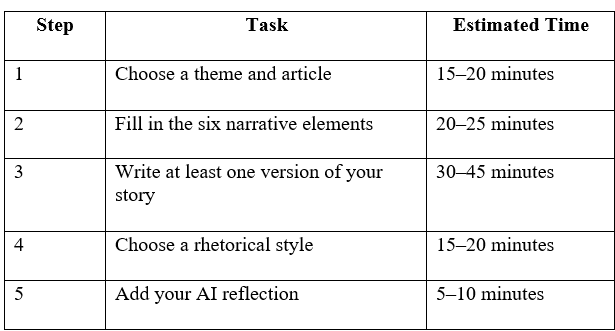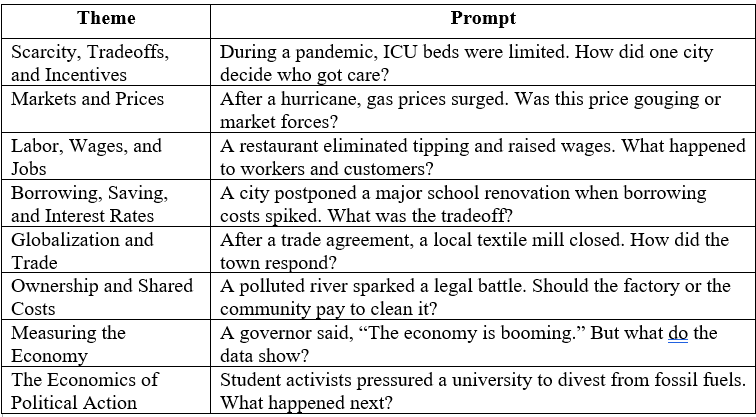Learning to Talk Like an Economist (Without Losing the Plot)
A short writing exercise that could help students speak clearly and confidently about economic narratives.
My four-week async summer course ends today. It’s been a good stretch and a chance to try out a few things I’ve been thinking about for fall.
This summer, I added another writing-to-learn assignment. It builds on a classical rhetoric exercise from the progymnasmata tradition. In this post, I’m sharing an example from the narrative version.
The assignment is my second round of experimenting with short writing tasks to help students prepare for a future elevator pitch: one minute to explain an economic idea out loud in front of peers. I am thinking the audience is a friend, family member, or hiring manager.
In a perfect world , students would work through several of these exercises across the semester. Each would help them make sense of what they’ve learned and talk about economics in a way that sticks.
Here is an example prompt for the narrative exercise that I created with AI assistance and suggestions from D’Angelo (2000). Next week, I’ll discuss my thoughts on the results, grading, and possible revisions for the fall. I will also brainstorm about how a future elevator speech assignment could work.
Moodle Page Introduction
Friday Focus: On two Fridays, you'll do a short writing activity designed to sharpen how you think, argue, and explain ideas. We'll use techniques from the progymnasmata: a classic set of tools for building arguments step by step. You'll practice narrative (telling and retelling stories) and inventing arguments (coming up with a problem and a deliberative argument).
ECO 1000 Narrative Assignment: Tell the Story Behind a Decision
Why am I doing this?
This assignment helps you build persuasive economic arguments by starting with a well-told story. Before economists explain causes or offer solutions, they look carefully at what happened. You’ll practice this kind of observation and explanation, laying the foundation for Learning Goal 1: “Explain how economists use economic thinking to ask good questions and gather information to answer them.”
You’ll choose a real event, break it down using a classical story structure, and explain why it mattered.
What’s the situation?
Imagine you're preparing to explain a high-stakes decision to a curious friend who’s not in this class. You've seen a decision in the news or on social media and people are debating it.
Your job is to step back, gather the facts, and explain what really happened:
What was the decision?
Who made the call?
What tradeoffs or pressures shaped it?
You’re writing for curious readers who want clarity. Help them understand what was at stake.
What will I turn in?
You’ll submit one PDF file that includes five steps:
Step 1: Choose a Theme and Article
Pick a theme and story prompt below. Then, find a real article related to it. Paste the link at the top of your submission.
AI Use Tip: You may use AI to brainstorm sample stories or refine search terms. But you must choose and summarize your own article.
Step 2: Fill in the Six Narrative Elements
Write 1–2 complete sentences for each:
Action – What happened?
Agent – Who made the decision or took action?
Time – When did it happen?
Place – Where did it happen?
Manner – How did it unfold?
Cause – Why did it happen?
AI Use Tip: AI may help rephrase or smooth your writing, but your answers should reflect your understanding of the story.
Step 3: Write One Version of the Story
Choose at least one version to earn full credit. Add a second version if you’re goal is an A.
Step 4: Choose a Rhetorical Style
Pick the tone that best fits your goals:
Direct – Clear, simple narration of the facts
Indirect – Uses “some say” or “reportedly” to show distance
Interrogative – Raises questions to prompt reflection
Comparative – Compares what happened to what could have happened
AI Use Tip: You may ask AI to help you explore tone or rephrase a sentence in different styles. Your final version and framing should be your own.
Step 5: AI Reflection (Required)
Write a short reflection on how you used AI in this assignment. Use the S.I.T. method:
What did you find Surprising, Interesting, or Troubling about using AI while writing?
Did AI help spark ideas, clarify tone, or organize your thoughts?
How might this shape how you approach writing in other classes or jobs?
Add this reflection at the end of your submission.
Final Submission Checklist
Before you upload your PDF, make sure it includes:
A link to your article at the top
One to two clear sentences for each of the six narrative elements
At least one version of your story (Condensed, Expanded, or Favorable Retelling)
A rhetorical style that matches your story
A second version (Expanded or Favorable Retelling) if you're aiming for an A
Your AI reflection at the end of the file
References
D’Angelo, Frank J. Composition in the Classical Tradition. Boston: Allyn & Bacon, 2000.





